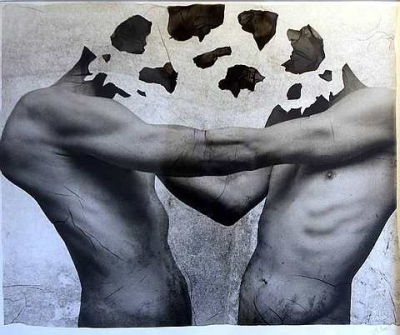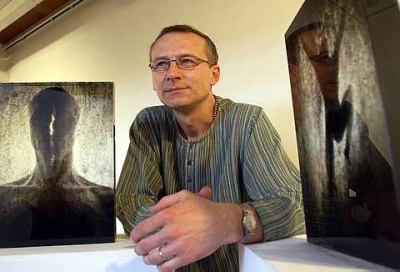The Star, 12 April 2009
Photo Jelly Art
by Andrew Sia
A Czech artist stretches photography to its limits by manipulating the actual material itself.
PICTURE a person clawing his own face, which is depicted as fragments of a torn photograph.
Is this the future of photography?
Well, not quite. This represents how far the 19th-century technology of black and white photography – the stuff of rancid chemicals in square metal pans, dark rooms and good old scissors – can go in the hands of 21st-century Czech artist Michal Macku.
Take his Untitled – Carbon Print No. 16, which shows several ethereal figures encased in multiple layers of glass, locked in a visual poem of eternal human yearning.
Or the stratification and overlay of men – again within manifold layers of glass – creating a ghostly effect reminiscent of a Nazi concentration camp in Untitled – Glass Gellage No. II.
The best part of all these images is that they are not the result of some sleight of computer chips; rather, they’ve been painstakingly handcrafted from fragile sheets of photo gelatin.
As Macku, 47, explained during the launch of his exhibition at Wei-Ling Gallery in Kuala Lumpur on Wednesday, he uses two processes to create his works. One is called gellage.
In traditional photography, a bright light shines through a “negative” film and creates a “positive” image on photo paper. Macku has replaced the paper so that the image is created on a large piece of “positive” film instead, made of countless silver particles in gelatin (thus it’s called silver gelatin).

Two photo gelatins (of the same person!) fight one another in Untitled – Gellage No. 69. Clearly, humans have many battles with their own demons.
He then cuts out the portions he wants from the positive film and bathes them in alcohol, then water, to obtain pliable pieces of translucent silver gelatin images – which he can further twist, turn or stretch before encasing them inside glass.
It all seems a bit like a school art workshop.
“In theory it sounds easy. But it has taken me years to perfect the craft,” said Macku, whose huge and powerful hands seem better-suited to grappling with tough clay rather than delicate photo gelatins.
Yet he has produced sublime, almost surreal, works with these techniques.
His Untitled – Glass Gellage No XVII shows how the struggle to remain still and meditate can seem like a kind of prison. The crucifix image (made up of many smaller crucified men) in his Untitled – Glass Gellage No. 5 is like an exhortation to follow the sacrificial example of a leader.
In Untitled – Gellage No. 69, two shadowy photos (of the same person, Macku pointed out) on a flat print fight one another, clearly reflecting mankind’s battles with its own demons.
“We do many things that are not good for us, just because of social expectations … and so we are full of tensions,” he commented.
In fact, it is the strikingly transcendent quality of his art that led gallery owner Lim Wei-Ling to make a special effort to bring Macku to Malaysia for his first show in Asia.
“There were more than 300 galleries showing works at the Milan Art Fair in spring last year,” recalled Lim. “I was walking for hours and feeling quite jaded from seeing the same kind of images. Suddenly, in a corner booth, I spotted his glass works and they were like a breath of fresh air.”
Macku has tertiary qualifications in both plastics technology and artistic photography. But over and above that is his nod to Edison’s adage that “inspiration is 99% perspiration”.
“I enjoy it when I cannot do something, especially when it comes to the technical problems of plastics and chemistry. For me, it’s like a puzzle or game, so I keep at it again and again until I get it right,” he said in halting, almost diffident, English.
His love for chemical puzzles has led him to work with another technique called carbon printing, where the image is formed not by silver particles (like normal film) but by chemically-treated carbon particles in gelatin.
“This is a 19th century type of photography that became extinct 80 years ago. It’s an almost forgotten process,” Macku explained. “But in the 1930s, it was used by the famous Czech photographer Frantisek Drtikol. I can feel his presence in old Czech photos and am inspired by him.”
During a talk at the opening of his exhibition, he selflessly shared the details of this painstaking process – which includes pouring the gelatin into hand-made glass pans, manually brushing the gelatin with a chromium salt, repeated soaking/dissolving/drying and long exposure to ultra-violet light.
Can computers create the kind of images he makes?
“I don’t think so. Anyway, computer images are too perfect,” he replied. “For me, every step (of technique) has a different energy, and is part of the creative process. It’s like putting a puzzle together.”
Dressed in an Indian kurtha and a bead necklace, Macku, who also practises yoga and meditation, revealed that his spiritual background inspires him for work.
“In substance, spirituality is all about coming from the heart, from an inner truthfulness,” he shared.
“My work places ‘body pictures’ in new situations, new contexts, new realities … I am interested in questions of moral and inner freedom. I do what I feel, only then do I begin to meditate on the result. I am often surprised by the new connections I find.”
‘Michal Macku – Glass (and) Gellages’, showing till April 30 at Wei-Ling Gallery (No. 8, Jalan Scott, KL), is supported by the Embassy of the Czech Republic. For more information, call 03-2260 1106 / 012-302 5302 or go to weiling-gallery.com.

